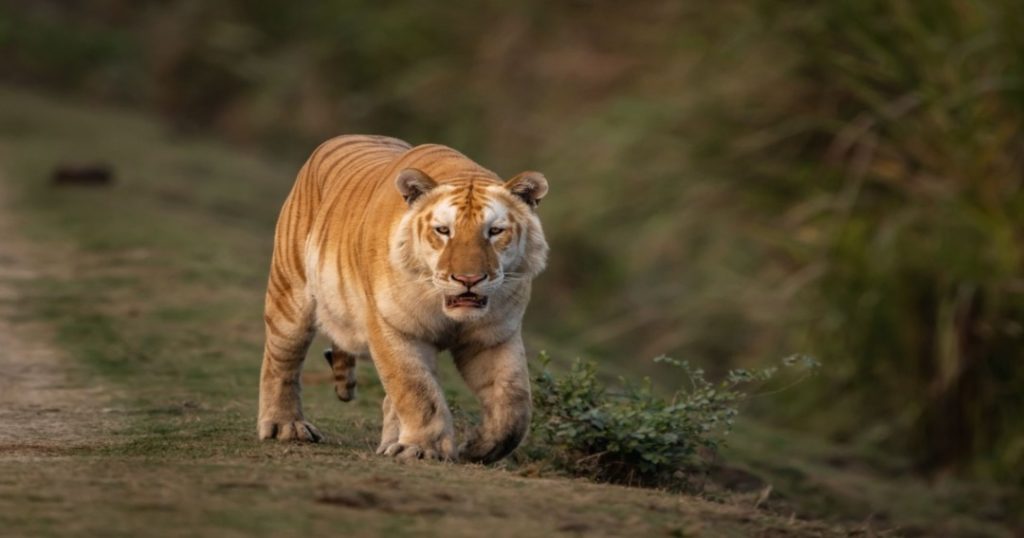
Kaziranga National Park, already known worldwide for its population of one-horned rhinos and big cats, has found attention returning to one of its rarest residents — the golden tiger. The unusual big cat, whose coat appears burnished gold with softer, faded stripes, was spotted again recently during an afternoon safari, leaving tourists and forest officials visibly thrilled.
The sighting happened in the park’s Central Range, when safari guides caught a glimpse of the tiger moving through tall elephant grass. The animal stepped onto the track briefly, pausing long enough for visitors to see the striking difference in its colouring before disappearing back into the thickets.
One of the tourists on the vehicle later described the moment as “completely unreal,” adding that the tiger’s coat “looked like sunlight moving through the forest.”
Forest guards confirmed the sighting later in the day, noting that they had already been monitoring movement in that area after earlier reports suggested the presence of a golden morph. This is not the first time Kaziranga has produced such a sighting — in recent years, the park has emerged as the only place in the country where these rare tigers have been photographed in the wild.
A Rare Coat, Not a Different Species
The golden tiger is a Bengal tiger with a recessive gene that alters its pigmentation. Instead of the usual deep orange, the coat takes on a soft golden tone, while the stripes fade to light brown or shadow-like bands. Only a tiny number of such tigers have ever been recorded in the wild, which makes every confirmed sighting significant.
Kaziranga’s field staff say this colour variation has now appeared more than once in the park, raising the possibility that the gene may be present in more individuals than previously believed.
Scientists Begin Genetic Study
Researchers from the National Centre for Biological Sciences (NCBS) in Bengaluru are working with forest authorities to collect genetic material through non-invasive methods, mainly through scat samples. The aim is to determine whether the tiger is part of a wider genetic line or whether the trait has appeared by chance.
The findings could offer insights into how rare recessive traits survive in wild populations. Some biologists believe the presence of such traits may simply reflect healthy genetic diversity. Others caution that repeated appearance of unusual colouration in a restricted area could also point to reduced genetic mixing. For now, the field team is focused on collecting enough samples to reach a reliable conclusion.
A Boost for Tourism, But With Limits
The sighting has already begun to stir interest among photographers, nature enthusiasts and documentary filmmakers. However, park authorities are careful not to encourage heavy traffic into the area where the tiger was seen.
A senior forest official said the goal is to “protect the animal first, celebrate the sighting second,” emphasising that the tiger should not be chased or disturbed simply for photographs.
Still, the presence of such a rare animal has undoubtedly given Kaziranga a new facet to its already rich wildlife identity. For many visitors, this is the kind of experience that stays with them long after they leave the park.
A Reminder of Nature’s Surprises
For all the scientific debates around genetics and population health, the golden tiger ultimately stands as a reminder of nature’s ability to surprise. In a forest where tigers are already difficult to spot, encountering one with a coat unlike any other makes the moment even more extraordinary.
Whether this rare variant appears again — or whether the tiger will remain an occasional, almost mythical presence — remains to be seen. But for now, Kaziranga once again holds the spotlight for a creature that looks as if it has stepped out of legend rather than the plains of Assam.


